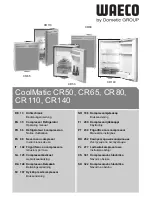
17
ENGLISH
OPERATION
723,&
3266,%/(&$86(
62/87,21
See “Installation Instructions—How to Level Your Refrigerator”
section on how to properly level unit.
Check gaskets for proper seal. Clean, if necessary, according to
cleaning instructions.
Door is not closing properly.
Check for internal obstructions that are keeping door from
closing properly (i.e. improperly closed drawers, ice buckets,
oversized or improperly stored containers or foodstuffs, etc.).
Controls need to be adjusted.
See “Installation Instructions—How to Adjust the Temperature
Controls” section on how to adjust your controls.
Condenser coils are dirty.
See section on “Hints and Care—How to Clean Your Unit” for
instructions.
Rear air grille is blocked.
Check the positioning of food items in refrigerator to make sure
grille is not blocked. Rear air grilles are located under crisper
drawers.
Reduce time door is open. Organize food items efficiently to
assure door is open for as short a time as possible.
Door has been opened frequently, or
has been opened for long periods of
time.
Allow interior environment to adjust for period the door has been
open.
Food temperature
appears too warm
Food has recently been added.
Allow time for recently-added food to reach refrigerator or
freezer temperature.
Refrigerator has an odor
Compartment is dirty or has odor-
causing food.
See section on “Hints and Care” for instructions.
Check gaskets for proper seal.
See section on “Hints and Care—How to Clean Your Unit” for
instructions.
Humidity levels are high.
Normal during times of high humidity.
Water droplets form on
outside of refrigerator
Controls require adjustment
See “Installation Instructions—How to Adjust the Temperature
Controls” section on how to adjust your controls.
Humidity levels are high or door has
been opened frequently.
See “Installation Instructions—How to Adjust the Temperature
Controls” section on how to adjust your controls.
Reduce time door is open. Organize food items efficiently to
assure door is open for as short a time as possible.
Water droplets form on
inside of refrigerator
Check gaskets for proper seal.
See section on “Hints and Care—How to Clean Your Unit” for
instructions.
Refrigerator or ice maker
make unfamiliar sounds or
seems too loud
Normal operation
Refer to noise section of troubleshooting guide.
Contents of drawer, or positioning of
items in the surrounding compartment
could be obstructing drawer
Reposition food items and containers to avoid interference with
the drawers.
Drawer is not in proper position
See section on “Refrigerator Features—Humidity-Controlled
Crisper Drawers” to verify drawer positioning.
Refrigerator is not level.
See “Installation Instructions—How to Level Your Refrigerator”
section on how to properly level unit.
Clean drawer channels with warm, soapy water. Rinse and dry
thoroughly.
Crisper drawers do not
close freely
Drawer channels are dirty or need
treatment.
Apply a thin layer of petroleum jelly to drawer channels.
Reduce time door is open. Organize food items efficiently to
assure door is open for as short a time as possible.
Doors have been opened frequently or
have been opened for long periods of
time.
Allow interior environment to adjust for period the door has been
open.
Humidity or heat in surrounding area is
high.
Normal operation
Food has recently been added.
Allow time for recently-added food to reach refrigerator or
freezer temperature.
Unit is exposed to heat by
environment or by appliances nearby.
Evaluate your unit’s environment. Unit may need to be moved to
run more efficiently.
Refrigerator runs too
frequently
Condenser coils are dirty.
See section on “Hints and Care—How to Clean Your Unit” for
instructions.
Trouble Shooting
















































